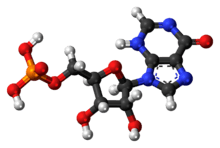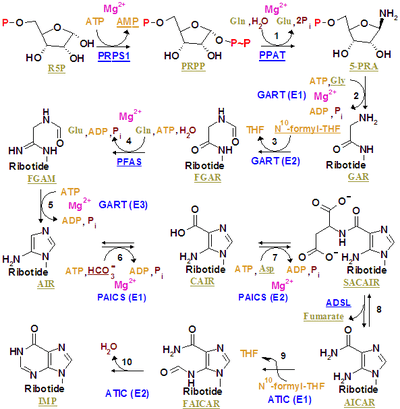Inosinic acid
 | |
 | |
| Names | |
|---|---|
| IUPAC name
5'-Inosinic acid | |
| Other names
IMP, Hypoxanthine ribotide | |
| Identifiers | |
| 131-99-7 | |
| 3D model (Jmol) | Interactive image |
| ChEBI | CHEBI:17202 |
| ChEMBL | ChEMBL1233478 |
| ChemSpider | 8264 |
| ECHA InfoCard | 100.004.588 |
| E number | E630 (flavour enhancer) |
| 5124 | |
| MeSH | Inosine+monophosphate |
| PubChem | 8582 |
| |
| |
| Properties | |
| C10H13N4O8P | |
| Molar mass | 348.21 g·mol−1 |
| Except where otherwise noted, data are given for materials in their standard state (at 25 °C [77 °F], 100 kPa). | |
| | |
| Infobox references | |
Inosinic acid or inosine monophosphate (IMP) is a nucleoside monophosphate. Widely used as a flavor enhancer, it is typically obtained from chicken byproducts or other meat industry waste. Inosinic acid is important in metabolism. It is the ribonucleotide of hypoxanthine and the first nucleotide formed during the synthesis of purine. It is formed by the deamination of adenosine monophosphate, and is hydrolysed from inosine. IMP is an intermediate ribonucleoside monophosphate in purine metabolism. The enzyme deoxyribonucleoside triphosphate pyrophosphohydrolase, encoded by YJR069C in Saccharomyces cerevisiae and containing (d)ITPase and (d)XTPase activities, hydrolyzes inosine triphosphate (ITP) releasing pyrophosphate and IMP.[1]
Important derivatives of inosinic acid include purine nucleotides found in nucleic acids and adenosine triphosphate, which is used to store chemical energy in muscle and other tissues.
In the food industry, inosinic acid and its salts such as disodium inosinate are used as flavor enhancers.
Inosinate synthesis
The inosinate synthesis is complex, beginning with a 5-phosphoribosyl-1-pyrophosphate (PRPP). In the first step, an amino group given by glutamine is attached at carbon 1 of PRPP. The resulting molecule is 5-phosphoribosylamine, which is highly unstable, with a half-life of 30 seconds at physiologic pH. 5-Phosphoribosylamine gains an amino acid (glycine), becoming glycinamide ribonucleotide (GAR). Then, N10-formyltetrahydrofolate (tetrahydrofolate) transfers a formyl group to glycinamide ribonucleotide to form formyl glycinamide ribonucleotide (FGAR).

Using an ATP molecule, glutamine donates an ammonia molecule which is added to the compound forming formylglycinamidine ribonucleotide. Another ATP molecule causes an intermolecular reaction that produces an imidazole ring (5-aminoimidazole ribonucleotide).
The next step of the pathway is adding bicarbonate to make carboxyaminoimidazole ribonucleotide by using ATP (it only happens in fungi and bacteria; high eukaryotes simply add CO2 to form the ribonucleotide). Then, the imidazole’s carboxylate group phosphatises and adds aspartate.
This six-step process links glycine, formate, bicarbonate, glutamine, and aspartate to lead to an intermediate that contains almost all the required atoms to synthesize a purine ring. This intermediate removes fumarate, and a second formyl group from THF is added. The compound gets cycled and forms inosinate after a sort of intermolecular reactions. Inosinate is the first intermediate in this synthesis pathway to have a whole purine ring.
Enzymes taking part in IMP synthesis constitute a multienzyme complex in the cell. Evidences demonstrate that there are multifunctional enzymes, and some of them catalyze non-sequential steps in the pathway.
Adenylate (AMP) and guanylate (GMP) come from inosinate
Within a few steps inosinate becomes AMP or GMP. Both compounds are RNA nucleotides. AMP differs from inosinate by the replacement of IMP's carbon-6 carbonyl with an amino group. The interconversion of AMP and IMP occurs as part of the purine nucleotide cycle.[2] GMP is formed by the inosinate oxidation to xanthylate (XMP), and afterwards adds an amino group on carbon 2. Hydrogen acceptor on inosinate oxidation is NAD+. Finally, carbon 2 gains the amino group by spending an ATP molecule (which becomes AMP+2Pi). While AMP synthesis requires GTP, GMP synthesis uses ATP. That difference offers an important regulation possibility.

Inosinate takes part in the regulation of purine nucleotides biosynthesis
Inosinate and many other molecules inhibit the synthesis of 5-phosphorybosilamine from 5-phosphoribosyl-1-pyrophosphate (PRPP), disabling the enzyme that catalyzes the reaction: glutamine-5-phosphoribosyl-1-pyrophosphate-amidotransferase. In other words, when levels of inosinate are high, glutamine-5-phosphoribosyl-1-pyrophosphate-amidotransferase is inhibited, and, as a consequence, inosinate levels decrease. Also, as a result, adenylate and guanylate are not produced, which means that RNA synthesis cannot be completed because of the lack of these two important RNA nucleotides.
Applications
Inosinic acid can be converted into various salts including disodium inosinate (E631), dipotassium inosinate (E632), and dicalcium inosinate (E633). These three compounds are used as flavor enhancers with a comparatively high effectiveness. They are mostly used in soups, sauces, and seasonings for the intensification and balance of meat taste.
See also
References
- ↑ Davies O, Mendes P, Smallbone K, Malys N (2012). "Characterisation of multiple substrate-specific (d)ITP/(d)XTPase and modelling of deaminated purine nucleotide metabolism". BMB Reports. 45 (4): 259–64. doi:10.5483/BMBRep.2012.45.4.259. PMID 22531138.
- ↑ Voet, D, Voet, J. G., Biochemistry (3rd Edition), John Wiley & Sons, Inc., 2004, pg 1095
Further reading
- Berg, Jeremy M.; Bioquímica; Editorial Reverté; 6ena edició; Barcelona 2007.
- Nelson, David L.; Principles of biochemistry; Editorial W.H Freeman and Company; 4th edition; New York 2005.